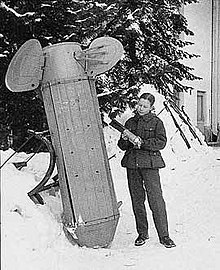| Revision as of 03:38, 31 May 2008 editJNW (talk | contribs)Autopatrolled, Extended confirmed users, Pending changes reviewers, Rollbackers58,813 editsm Reverted edits by Theantiwbc (talk) to last version by ClueBot← Previous edit | Revision as of 03:40, 31 May 2008 edit undoTheantiwbc (talk | contribs)36 edits Undid revision 216114075 by JNW (talk)Next edit → | ||
| Line 1: | Line 1: | ||
| ] | ] ]]] | ||
| '''Molotov bread basket''' is the ] name for ] RRAB-3 droppable bomb dispensers that combined a large high-explosive charge with a cluster of incendiary bombs. It was used against the cities of ] during the ] of 1939–1940. The bomb consisted of a cylinder 2.25 m / 7.5 feet long and 0.9 m / 3 feet in diameter. | '''Molotov bread basket''' is the ] name for ] RRAB-3 droppable bomb dispensers that combined a large high-explosive charge with a cluster of incendiary bombs. It was used against the cities of ] during the ] of 1939–1940. The bomb consisted of a cylinder 2.25 m / 7.5 feet long and 0.9 m / 3 feet in diameter. | ||
Revision as of 03:40, 31 May 2008

Molotov bread basket is the Finnish name for Soviet RRAB-3 droppable bomb dispensers that combined a large high-explosive charge with a cluster of incendiary bombs. It was used against the cities of Finland during the Winter War of 1939–1940. The bomb consisted of a cylinder 2.25 m / 7.5 feet long and 0.9 m / 3 feet in diameter.
Described by journalist John Langdon-Davies in 1940:
As it fell from an aircraft, a small turbine on the nose turned to release a spring loaded casing which, on opening, scattered 100 or more incendiary bombs; the main HE charge in the tail of the weapon continued to fall as a conventional bomb.
This description seems to have become common currency among the British public in 1940.
However, other descriptions make no mention of a main charge and instead describe a large cylinder with vanes at the back that open out when the weapon is dropped. The vanes cause the bomb to spin and this has the effect of opening the sides and scattering the submunitions by centrifugal force.
In 1939 the Soviet Foreign Minister, Vyacheslav Molotov, claimed Russia was not dropping the bombs on Finland, but merely airlifting food to starving Finns. In addition to naming the bombs after the politician, Finns started calling an improvised incendiary device; the Molotov cocktail "a drink to go with the food".
See also
References
- *Langdon Davies, John (1940). "The Lessons of Finland". Picture Post.
{{cite journal}}: Unknown parameter|month=ignored (help); Unknown parameter|quotes=ignored (help) - "WW2 People's War (BBC)". Recollections of Olive Mary Barrow - witness to a German incendiary attack. Retrieved 2007-04-16.
- *"Big Russian Bomb Holds Sixty Little Ones". Popular Science. 1940.
{{cite journal}}: Unknown parameter|month=ignored (help); Unknown parameter|quotes=ignored (help)
- "WW2 People's War". BBC. Retrieved 2007-04-24. - 'WW2 People's War is an online archive of wartime memories contributed by members of the public and gathered by the BBC. The archive can be found at bbc.co.uk/ww2peopleswar'